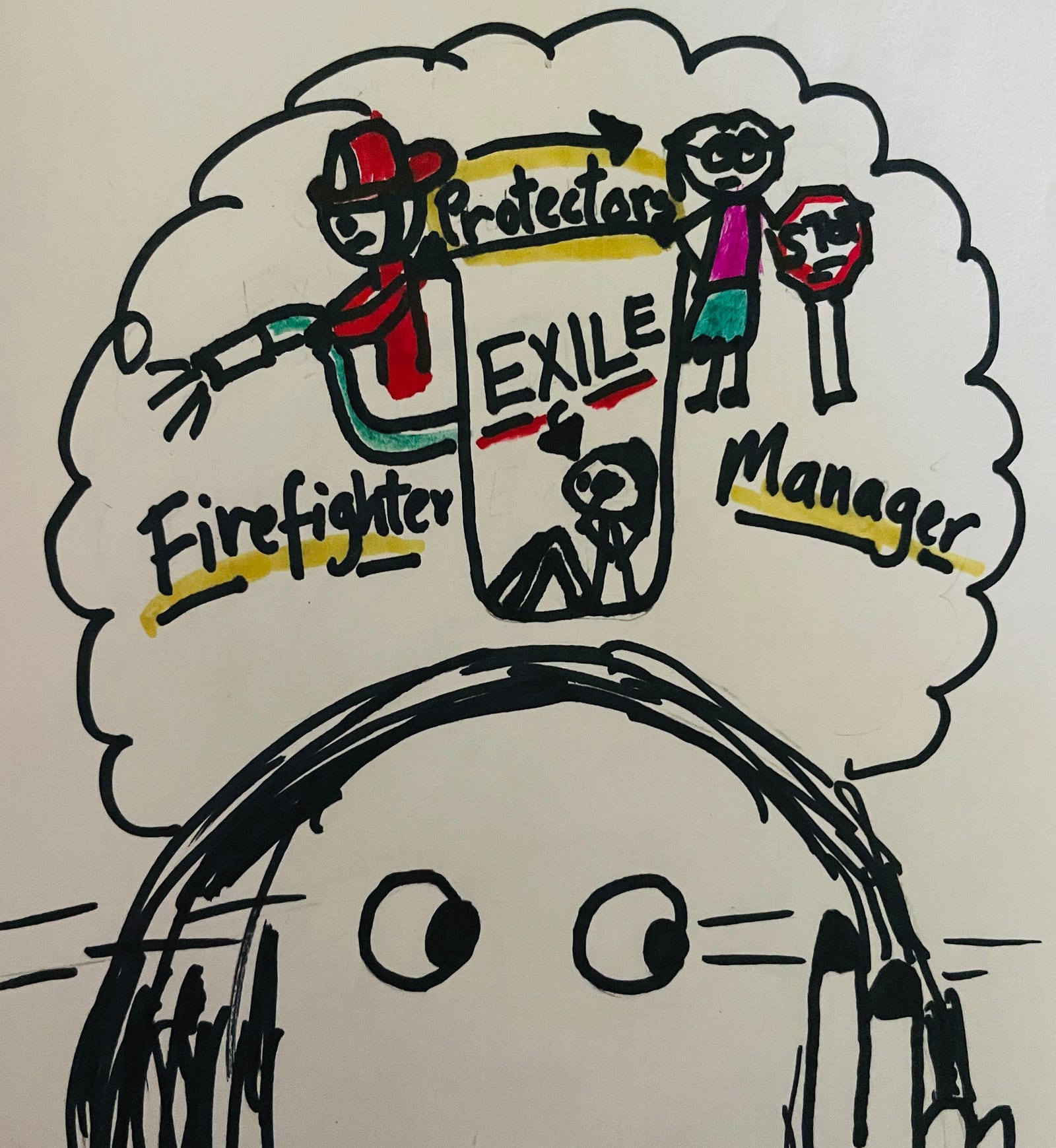
“Breathe deeply.”
I close my eyes and belly breathe as my EMDR therapist scoots her chair closer. This is standard practice in our weekly sessions. Soon she’ll tell me to open my eyes, focus on a certain phrase or idea, and follow her finger left and right. Sometimes fast, sometimes slow. Crossing the brain hemispheres is supposed to help process and eventually heal trauma.
At first, my trauma wouldn’t budge from its hiding places. I don’t blame it. Covert narcissistic child abuse is no joke. From a young age, I was taught that emotions were dangerous and that I was to blame for some pretty scary stuff. That caused Complex PTSD, layers of trauma that constantly get re-traumatized. Basically, my fight or flight got permanently switched on so I’ve been in survival mode my whole life. It’s really challenging to undo.
The more I learn about INTERNAL FAMILY SYSTEMS, the more fascinated I become. My non-mental-health-professional understanding is:
In order to protect itself from melting down, my brain split into parts (trauma-splitting or fragmentation). I have 4yr old, 6 yr old, 12 yr old Jamies that hide separately, each with their own unprocessed trauma. These EXILES are deep-rooted and heavily protected.
When I first sought help I said “it feels like I have a Manager personality that allows me to do functional things, like grocery shopping while I’m having a panic attack.” It turns out I was right. The PROTECTORS are called MANAGERS and FIREFIGHTERS.
The MANAGERS help with functional things like sleeping, eating, interacting, and focusing on goals. They keep us in our heads to help us AVOID danger.
FIREFIGHTERS help when they think we ARE in danger. They send us signals through our bodies that distract us in order to help. They are also responsible for unhealthy behaviors like addiction.
6 months of weekly EMDR (Eye Movement Desensitization Reprocessing) sessions showed me just how strong and prepared my protector parts are. I get sudden pangs of hunger, exhaustion, muscle cramps, tinnitus— anything my body can think of to keep me from accessing the trauma itself. When things get really bad, I can lose my ability to read, like my brain unplugging things so they don’t blow a fuse.

Still, there’s progress. I’m more aware of how my parts work and am even able to loosen some muscles. I just haven’t BEFRIENDED them, which I’m told is the key to healing. When I get frustrated, I picture my friend giving his mother CPR at Christmas, unable to revive her. If EMDR helped him heal that, it can help me.
Through trial and error, my therapist realized that I respond best to storytelling and visuals. My answers have slowly moved from “I don’t know” to more detailed information. Today we’re doing an activity called COMMUNITY ROOM.
“Just breathe. Picture a room…”
Picturing a room is good. It gives me a concrete image to start from. Without this detail, I get lost in racing thoughts. Overwhelmed. This used to happen when I was in school. I just needed one thing to focus on to be successful, which was not how the school worked.
“Let me know when you see the room”
After a few minutes…I see it!
“Open your eyes and follow my finger.”
Left right left right…
“Take a deep breath. What do you notice?”
A deep starvation burns from my throat to my sternum. I always eat before my sessions, because this firefighter constantly shows up. It helps me distinguish what it actually is. The hunger shows up at home too, which makes me overeat, often never feeling full. Then I feel shame and it sends more hunger. Oy!
“Ask the hunger how old it is.”
This is new. Usually, she just reminds me it’s a firefighter. Hmmm…breathe deeply, focus internally…how old are you?
8 jumps right up. Ok, 8 and…16.
“Ok, ask 8 and 16 if we can have permission to move forward.”
I ask and suddenly memories from those ages clog my brain at once.
“It’s ok, put those in the container. Tell them we’ll get to them later.”
In our first sessions together I created an imagined container to put distracting thoughts. We use this a lot and I use it at home. Accepting and managing instead of denying. Denying is what makes things worse.
“Ok, do we have permission to move forward?”
Yes. The hunger instantly disappears. It still boggles my mind how all of this works. I’m talking to my younger parts and they’re answering?!
“Now, invite all of your parts to join you in the room.”
Between eye movements, I close my eyes, breathe deeply and invite my parts. They’re reluctant. I’m not surprised. We’ve previously been able to access my parts for just a few seconds. Then they suddenly turn to demons and attack me.
“Let them know they don’t have to do anything but show up.”
Instant relief rushes through my body. I hadn’t even realized how tense my shoulders were until she said that. They loosened immediately and parts started showing up! The really young ones first, 4, 6. Then some of the older, 11, 12, 13. Then a block.
9 or 10 doesn’t feel safe. I can feel their fear.
“Ask them what they need.”
A blanket and a chair to hide under.
“Give them a blanket and a chair.”
I imagine a blanket and a chair. The part scurries underneath
Whoa! 16 is angry, hostile. Like tiny little stabs in my brain.
“Ask 16 what they need.”
To get the FUCK out of here (16’s words). They’re furious. Stomping, arms crossed. Standoffish.
“What does she need in order to do that?”
A car. I imagine a car. She gets in and takes off. I don’t blame her. 16 was filled with traumatic experiences. It was the age I fully realized that my father was not a parent and that he meant me harm.
My parts fill the room now, sitting around a giant table drinking chocolate milk and water. Why? I’m not sure. They’re joyful, the way my theme park co-workers and I were when management brought cake. It’s a real “characters love cake” vibe.
I see myself sitting at a giant drawing table watching all of the parts enjoying themselves. From the tips of my fingers, across my shoulders and all the way down my other arm are soldiers standing guard, tall spears in their hands and helmets on their heads. That makes sense since those muscles are constantly tight.
We spend some time in the room exploring who’s in attendance. Processing a few emotions with eye movement and deep breaths, our hour is up.
“When you’re ready, open your eyes and return to the room.”
Done.
“Really great work today. For homework, I’d like you to draw the Community Room”
No problem. It’s so vivid in my head. Ta-dah!

After 6 months of weekly sessions, we finally accessed my parts AND they agreed to come together, which is the ultimate goal. We’ll use this room in future sessions to strengthen their bond and begin to heal the actual trauma. Looking forward to being a cohesive team instead of a body of fragmented parts. Let the befriending begin!
Guest Post Disclaimer: Any and all information shared in this guest blog post is intended for educational and informational purposes only. Nothing in this blog post, nor any content on CPTSDfoundation.org, is a supplement for or supersedes the relationship and direction of your medical or mental health providers. Thoughts, ideas, or opinions expressed by the writer of this guest blog do not necessarily reflect those of CPTSD Foundation. For more information, see our Privacy Policy and Full Disclaimer.

Creative storyteller and recovering scapegoat of a narcissistic parent, working through Complex PTSD one post at a time




Thank you for this very clear and coherent account of your experience with EMDR and Internal Family Systems work. As a sufferer of CPTSD I have read widely on both these systems without fully understanding how they are applied or how they work.
Very well explained! You have me in tears!